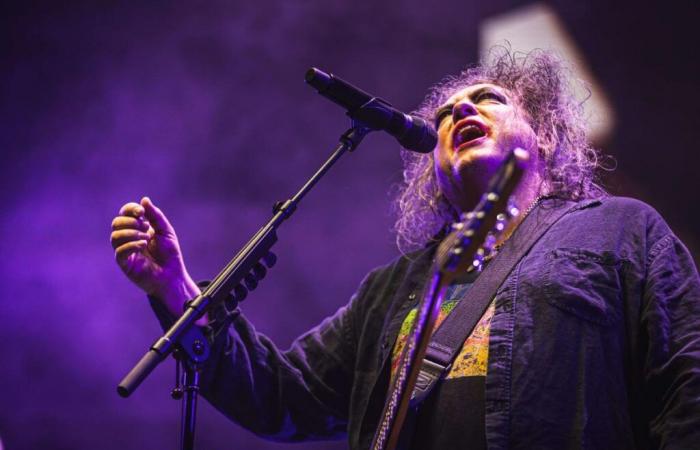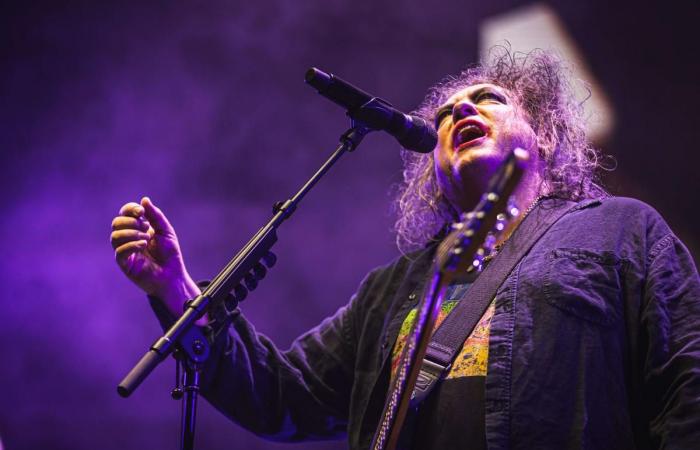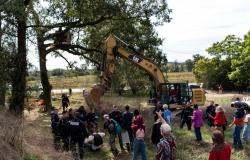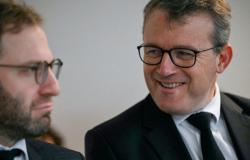The same evening as the release of their event album, “Songs of a Lost World”, The Cure gave a three-hour concert at the Troxy, in London. We were there.
Robert Smith at a The Cure concert in 2023. Photo Dave Decker/Shutterstock/SIPA
By Hugo Cassavetti
Published on November 2, 2024 at 11:37 a.m.
Lhe Troxy, an art deco theater, sits in the heart of Stepney, in the East End of London. Built in 1933, it was for a long time the largest and most prestigious cinema in the United Kingdom until the district, after the war, became one of the most damaged and disreputable in the capital. Converted in 1962 into a rehearsal venue for the Royal Opera House and then into a popular bingo den, the Troxy became a magnificent concert hall in 2006. An institution on a human scale, with intact charm, a place steeped in history, of unchanging elegance. The ideal setting to host the show event given by The Cure, on 1is November, to launch their long-awaited latest album Songs of a Lost World.
The places, naturally, were snapped up in a few minutes and, from 5 p.m. – too bad for tea – the queues lengthened along the brick walls of the building. The ravens of yesteryear, those fans with impressive black and invasive hairstyles, are now rare, but the fervor and excitement of the fans are no less palpable. The day began with the discovery of the new album by their favorite group, a unanimously acclaimed splendor, before ending with its live rendition (and broadcast live around the world) in front of 3,000 privileged people.
Robert Smith and his complaint, always passionate
Did Robert Smith expect such a warm reception for the most melancholic and, at times, desperate album of his career? In any case, the rare quality that he possesses among his many others is that of never being or appearing jaded. Totally invested in his performance, as if he were reliving each word he sings each time, the love his audience has for him leaves him speechless. At least, to speak to him between songs. Because in memory, we had never heard Smith, now 65 years old, sing with a voice as assured as it was vibrant, faithful to this heartbreaking death rattle, this passionate, so particular complaint, revealed from the first recordings, so many years ago a long time.
Also read:
The best of The Cure in sixteen luminous spleen titles
“I was going to say that these songs will take us back thirty-five years, he blurted out, after two hours, beginning a long dream sequence devoted to Seventeen Seconds, but I realize it's actually forty-five years! » Almost half a century. We measure the exception of The Cure. Of Songs of a Lost World, delivered in order and in its entirety, with an intensity which only further highlights the strength and relevance of the work, up to these songs written at the end of adolescence, the coherence and constancy are dizzying . Like the worried and prescient diary of a young man who has understood everything about his/her life: the long crossing of a frightening forest which does not lead to any clearing, only saved by precious childhood memories and dreams and a few encounters miraculous.
The Cure is getting younger before our eyes
Miraculous, because of his current group – notably the immovable traveling companion Simon Gallup, bassist hopping among his static acolytes, and the guitarist Reeves Gabrels who we have never heard so invested in his solos -, to his multitude of fans, the eternal loner is reminded at each of his concerts that he is far from being alone on his agonizing path. Death and oblivion, in the end, are inevitable, but love and flashes of joy or happiness are not illusory. Of Pictures of You, central piece of Disintegration, little played M, drafted as the rarest yet Secrets, of Seventeen Seconds, Smith never misses an opportunity to celebrate his lifelong companion.
And it is through this marvelous countdown, this enchanting return on its steps, exploding with renewed vitality, that The Cure seems to rejuvenate before our eyes. After the majestic sequence, of poignant solemnity, ofAloneA Fragile Thing, I Can Never Say Goodbye which ends with a Endsong devastating, the group returns after a short break with an inspired shot of Disintegration (of Plain Song has Fascination Street) as if to confirm its lineage, thirty-five years later. A Love Song weightless blends into a Burn incandescent, before taking a further step backward to return to the era of Head on The Door. And Push wild in the face of an exulting crowd makes the connection between A Night Like This imperial and a In Between Days echoed by the whole room.
Also read:
In 1992, The Cure and his group therapy in “Télérama”
Extract point – too deadly? – of Pornography this time. A Night, Play For to Today and the essential A Forest rather reconnect with the true birth of the Cure sound and aesthetic, these 1980 titles gaining power while preserving their grace. It could have already ended in style. But Robert Smith doesn't know, doesn't want to stop, and it's a wild salvo of hits that he serves as a final bouquet, with Lullaby, The Walk, Friday I’m in Love, Close to Me and, finally, a furious Why Can’t I Be You ? on which he even finds his funny little disjointed rag doll dance steps.
Thirty-one titles in three hours, and not a minute too long. Smith, who gave everything, seems as moved as we are. He has what it takes. The words of Lovesong must never have resonated so loudly in his head. “When I'm alone with you, I feel like I'm home again. When I'm alone with you, I feel like I'm whole again. When I'm alone with you, I feel like I'm young again. When I'm alone with you, I feel like I'm happy again. »







